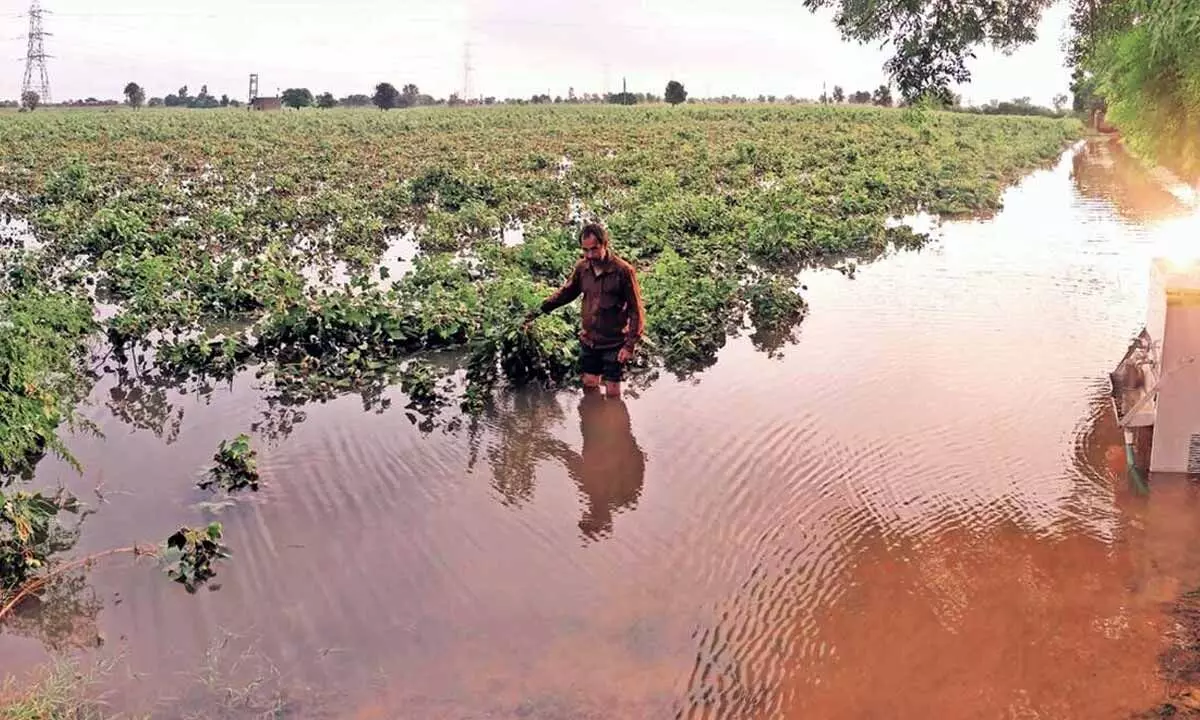Unseasonal rains may play havoc, increase inflation
Different parts of country received excess rainfall up to 700%; Mostly cereal producing states affected a lot; The damage caused by heavy rains may adversely impact prices of cereals and vegetables
image for illustrative purpose

Unseasonal rains can play a large role in impacting the inflation trajectory. Terminal repo rate might go higher than 6.5 per cent as Fed rate hike now at 125 bps in 2022, says an internal report by the economic research wing of SBI.
CPI inflation for September jumped to 7.41 per cent. A decomposition of CPI food inflation into sub-components shows that on a weighted contribution basis, the food inflation was driven by cereal products and vegetables. The seasonal impact of rains on vegetable prices will now become discernible. Going forward, the unseasonal rains in different parts of country up to 700 per cent in cereal producing states could have a significantly large impact on cereal and vegetable prices, the report said.
According to it, in 2019, unseasonal rain that was much lower in proportion had pushed food prices up firmly by 3 per cent over the four month ended Jan'20. However, food inflation cooled soon after with vegetable prices significantly declining by Mar'20. The problem however continued with cereal prices at high levels as such prices are sticky downwards and takes time to mean revert. Due to unseasonal rain pattern and frequency being witnessed across major states now, surge in food inflation may led to inflation for December hover above 7 per cent and the quarterly average should come around 7 per cent, above RBI's projection (6.5 per cent). An eerie similarity with 2019 inflation trajectory could now mean that RBI and market inflation estimates could go awry.
"With increased Fed rate hikes in 2022 and an adverse inflation forecast, RBI will have to walk a fine balance of rate hikes. We believe that the terminal repo rate in the current cycle could now extend till Feb'22, with a 50 bps rate hike penciled in December policy. The only solace could be a lower crude price and the negative growth in protein rich item eggs and steady deceleration in prices of meat and fish. We are now looking at the terminal repo rate going higher than 6.5 per cent," said Soumya Kanti Ghosh, chief economic advisor, SBI Group. Meanwhile, capacity utilization of manufacturing companies after reaching high of 75.3 per cent in Q4 FY22 had declined to 72.4 per cent as per the latest RBI OBICUS survey. However, growth in bank credit was seen across all major sectors with 16.4 per cent growth as per the latest number as of September 23. Apart from personal loan, it seems corporate working capital utilisation is continuing to be robust and driving the credit offtake, he added.
New investment announcements in Q1 FY23 had declined to Rs 4.35 lakh crore as compared Rs 5.75 lakh crore in Q4 FY22. However, as per provisional numbers in Q2 FY23, the same has increased to Rs 7.73 lakh crore with major contribution from Vedanta for its display unit and semiconductors factory in Gujarat worth more than Rs 1.50 lakh crore. Major industries where new announcements were made during Q2 FY23 includes electronics, roadways, shipping infrastructure, basic chemicals, metals, real estate, community services and non-conventional power etc. Thus growth has continued to stay robust, the report said.
"Even as Indian economy has been able to navigate through the crisis, global uncertainties is beginning to take a profound toll. Specifically, the US credit markets are now increasingly appearing jittery. The trends in the Bloomberg 'Yield-to-Worst (YTW)' index for US investment grade, high yield (or junk) bonds and US Corporate long bonds show trends similar to 2010 levels. This duration of this 'new' credit regime is likely to last for some time at least till 2023 when the Fed rate is expected to peak," Ghosh added.
The current build-up of risk in the US credit markets has been a long drawn structural change which has been tracked since 2018. The IMF's Global Financial Stability report in April 2018 had noted that BBB bonds now make up nearly 50 per cent of the index of investment grade bonds (up from 25 per cent in 1990), an all-time high. Bonds with the lowest investment grade rating amounted to one third of bonds outstanding and, over the past year, debt loads had increased the most for companies with weak balance sheets. The increase was mostly at the expense of bonds rated AA and above, whose current share is less than 10 per cent, down from more than 35 per cent 30 years ago. The steady decline in the share of high-quality bonds (AA-rate and above) indicates search for yield in an environment of persistently low interest rates.
Meanwhile, US housing markets show that the four major territories where home sales data are collated show varying trends with home sales not picking in important geographies. Existing (previously owned) home sales in the US edged 0.4 per cent lower (seasonally adjusted) to 4.8 million in Aug'22, the lowest figure since May'20, continuing the course from a downwardly revised 5.7 per cent fall in July.
According to Ghosh, growth estimates for India has already been downwardly revised. With the entire world facing the spectre of unprecedented recession in 2023, India still stands like an oasis in an era of uncertainty. However, we must temper down on our growth expectations in FY23 and FY24 from current estimates. A 6-7 per cent or even below could become the new normal! Even then India will still remain the fastest economy in world by a large margin.

